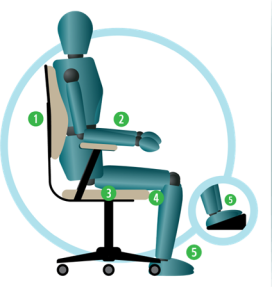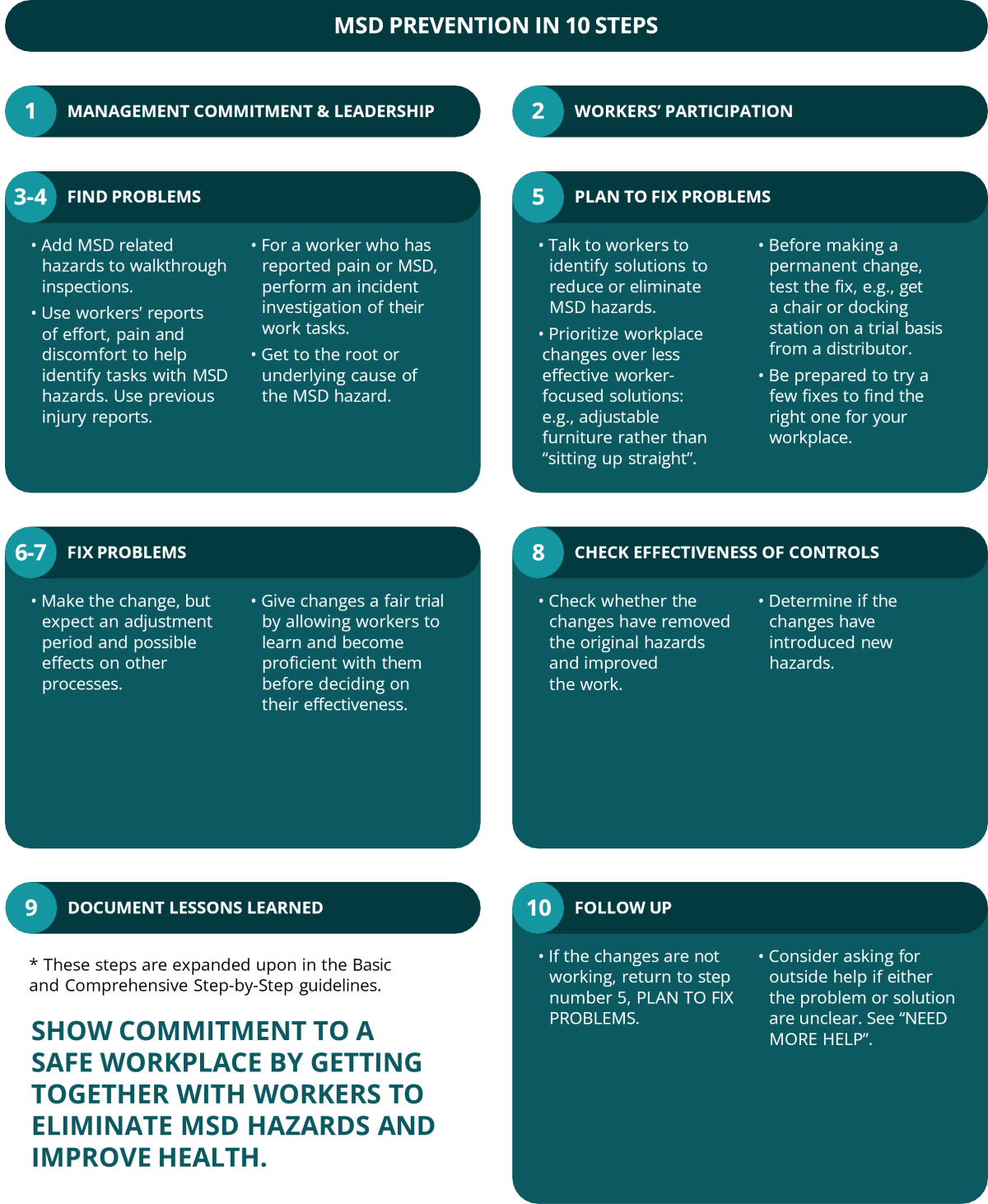On this page
Introduction
Back pain, sore wrists and necks, and other Musculoskeletal Disorders (MSD) are a major cause of workers’ disability and costs to workers, businesses, and society. Eliminating and reducing MSD hazards at the office is part of creating a safe workplace.
Small changes in the office can make a big difference in preventing the development of MSD. The goal of “Office Ergonomics” is to improve health and effectiveness during office work.
This Guide contains quick workplace fixes to help keep workers free of MSD while performing office work. It provides basic information and encourages businesses to get started on preventing MSD during office work and helps workers configure their workstations. The Office Quick Start Guideline is comprised of fact sheets and posters that can be downloaded and distributed freely.
Set up your office workstation effectively
Note that there is no single "correct" working position that fits everyone's body and work tasks, and that allows comfort for extended periods of time. The Guideline documents aim to provide help with achieving postures and workstation setups that position workers to minimize the occurrence of MSD. Remember, movement while sitting or standing as well as whole body activity (i.e. walking) are important components of office work and reducing MSD.
Quick Start Guideline Introduction Video
New to the MSD prevention quick start guidelines? This short animated video shows what is included in the quick start guidelines, and provides examples of how they can be used to prevent MSD in your organization today.
Small changes can make a big difference! A workplace free of MSD hazards protects workers now, allows injured workers to return to their jobs more easily, and allows more people to perform those jobs.

Quick Start Guide Office: Folder
The PDF creates a folder that can hold the mini-posters and gives information about MSD and Prevention and how to use the mini-posters. The folder and mini-posters together are a self-contained resource.
Experiencing pain or discomfort? Try these quick MSD prevention actions
Employers are responsible for taking every precaution reasonable in the circumstances for the protection of a worker under the Ontario Occupational Health and Safety Act. This includes improving the workplace and implementing measures to protect workers from all hazards, including those related to musculoskeletal disorders.
How to use the posters?
- Use the posters as guides during workplace walkthroughs and inspections. On the back of the poster, write observations and ideas about possible fixes for hazards.
- Use the posters as a script to aid workers, supervisors and others during safety or toolbox talks. Use the discussion to brainstorm possible fixes.
- Use the posters in the lunchroom or on the Health & Safety board to alert workers to potential MSD hazards in their work and their relationship to pain and discomfort.
- As a reminder to keep looking for improvements!
Each poster describes a common workplace hazard that can lead to an MSD. It also gives ideas on how to fix it. MSD hazards can be found in all sizes of workplaces and in all sectors. You may recognize some or all six hazards in your workplace. This tells you that your workplace needs a plan for MSD prevention action.
Office Ergonomics
Key fixes for preventing MSD in office work.
Change it up: Move
Changing position and tasks regularly is critical for health and effectiveness.

Support the body
Reduce fatigue by supporting your body.
Support the arms
Reduce fatigue by supporting the arms.
See: The body follows the eyes
The head and trunk can be pulled into awkward positions when workers strain to see their work.
Reach: Keep it close
Set up the workspace with frequently used equipment conveniently close to your body.
Work Shouldn't Hurt
Find jobs that may have MSD hazards.
Sit-Stand Workstations
Change it up! Move early, before you feel pain, and move often.
Quick Start Guideline: 11" x 17" Poster
Use the 11” x 17’’ poster in the lunchroom or on the Health & Safety board to alert workers to potential MSD hazards in their work and their relationship to pain and discomfort.
Making a start
Starting is the most important part of reducing back pain, shoulder tendinitis, tennis elbow and other Musculoskeletal Disorders (MSD). This package will give you a good start. Some of the ideas may seem very simple, but you can substantially reduce MSD hazards by applying these ideas throughout your workplace (and at home).
The mini-posters give you the general idea behind the solution. For example, STORE IT OFF THE FLOOR shows how to store objects. It’s the same rule for storing boxes in an office, moving parts in manufacturing, or setting up stands and work surfaces for heavy tasks in construction.
Actions
- Jump straight in. Start using these posters in your workplace inspections and toolbox talks and make changes to remove or reduce any hazards identified.
- Follow the 10 steps for a more systematic approach.

Want to search the resource library?
Find all the available resources on the MSD prevention website, including posters, videos, and links to relevant websites.


